
Poker is a game full of strategies, and one technique that often leaves players intrigued is the check-raise. Whether you're a seasoned card enthusiast or a beginner learning the ropes, understanding the check-raise can hugely impact your gameplay.
But what exactly is a check-raise, and why do some players find it so thrilling? This manoeuvre can be a game-changer, offering opportunities to possibly turn the tides in your favour.
In this post, we're going to break down what a check-raise is, look at the reasons why players use it, and explore the best times to pull this move from your poker toolkit. Dive in to discover how this strategic play can add a new layer of excitement and skill to your poker experience.
What Does Check-Raise Mean In Poker?
A check-raise is a clever tactic used in poker to outsmart your opponents. At its core, it starts with a check, which happens when a player decides not to bet and instead passes the turn to the next player without putting money in the pot - it’s important to note that you can only check if no bets have been placed in this betting round yet. This might seem passive, but that's where the strategy comes into play.
After checking, if another player bets, the original player who checked gets the chance to call the bet or raise to increase it further when it's their turn again. For a check raise, this is where the raise comes into it. So, instead of simply calling the new bet amount, you raise and increase the bet amount further, meaning the seemingly passive turn suddenly turns aggressive.
The idea behind a check-raise is to trick opponents into thinking you're not interested in your hand. This can tempt them to bet, giving you the perfect opportunity to raise the stakes when your turn comes around again.
Check-raising is most effective when used sparingly and with careful thought. If opponents catch on to this play, they might become wary and adjust their strategies. So, like any poker move, timing and understanding your opponents' behaviour is key.
Why Use Check-Raise In Poker?
Employing a check-raise in poker can be a powerful tool for several reasons. At its heart, this tactic is all about gaining control and dictating the pace of the game.
One main reason players use a check-raise is to build the pot. By initially checking and then raising after an opponent bets, you can increase the amount of money you stand to win if your hand is strong. It's particularly effective if you're confident your hand has a good chance of winning.
Check-raising can also be used to bluff and create confusion for your opponents. By making them think you've got a stronger hand than you actually do, you may be able to pressure them into folding their hands.
The move can additionally help gather insights into your opponents' hands. If you check, you encourage others to reveal a bit more about their cards through their betting actions. This can provide valuable information to guide your decision-making as the round unfolds.
However, like any strategy, using the check-raise requires careful timing and good judgement. It's most effective if you have not yet used it, a clear read on your opponents and a well-thought-out plan for your next move.
Is It Considered Bad Etiquette To Check-Raise?
In the world of poker, etiquette plays a significant role, but when it comes to using the check-raise, it's generally not seen as bad manners. In fact, it's considered a standard and legitimate part of the game.
While some might view it as a sneaky move, most experienced players understand that poker is a game of strategy. Using a check-raise is just one of the many tactics available to outwit your opponents and show your skill.
However, it's important to be mindful of how often you use it. If overused, it can irritate some players, not to mention it can lose its intended effect. The key is balance and knowing when it's appropriate to employ this strategy.
Overall, as long as you use the check-raise sparingly, thoughtfully and with respect for your fellow players, it remains an acceptable and even respected part of poker play.
When To Check-Raise In Poker?
Deciding when to use a check-raise in poker can significantly affect your success in the game. Here, we'll look at two key situations where this tactic can be particularly useful.
Check-Raising As a Bluff
One clever application of the check-raise is to use it as a bluff. By initially checking, you project the image of having a weaker hand, encouraging your opponents to bet confidently. When your turn comes around again, you surprise them with a raise, suggesting a strong hand.
This can make opponents reconsider their own hand and may lead them to fold, leaving the pot for you. It's a risky move, but if employed against the right players and at the right time, it can be an effective strategy.
Check-Raising To Get Opponents To Add Money
Another time to use a check-raise is if you have a strong hand and want to increase the pot size. By checking first, you suggest to your opponents that you may not have the strongest hand, which may get them to place bets. Then, raising after they've committed some chips can significantly boost the overall pot.
This tactic works best if you're fairly confident in your hand and its potential to win, allowing you to maximise your earnings from each round. Using the check-raise in this way is all about making the most of strong hands.
Remember, there is always an element of chance in poker despite it largely being a game of skill and strategy, so always make sure to gamble responsibly and only place bets you are comfortable with.
**The information provided in this blog is intended for educational purposes and should not be construed as betting advice or a guarantee of success. Always gamble responsibly.
